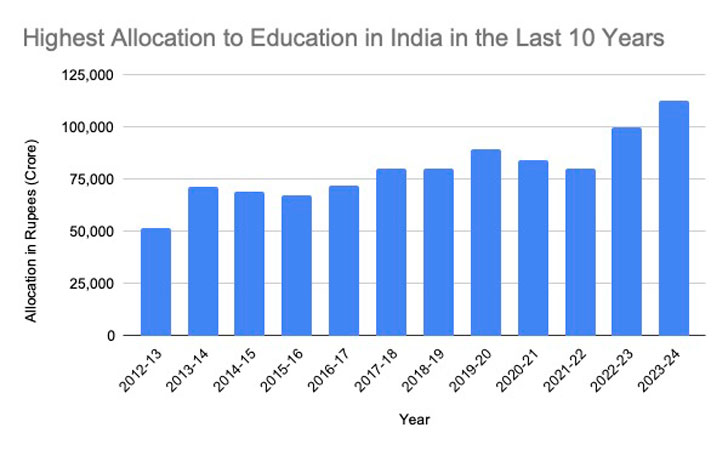
Characterized by a flourishing demand for international schools, the educational landscape in India is undergoing a significant transformation. This trend is not only reshaping the way education is delivered but also how it is perceived by a society that increasingly values global standards and quality learning experiences.
Economic Factors
India's economic progress has been a major catalyst for the expansion of the international school market. The country's increase in gross domestic product has translated into higher disposable incomes for a larger segment of the population, enabling more families to seek out the best educational opportunities for their children. This economic growth along with a keen awareness of global educational trends, has led to a surge in enrollments at international schools. Over the past academic year, these institutions have welcomed over 416,000 students aged 3 to 18, a testament to their growing appeal among Indian families (ISC Research India Report 2023-24).
Another major driver is the intentional allocation of funds to the education sector. Not only has the trend grown over the last decade, but it has also indicated the country’s commitment to higher education.

Social Factors
The allure of international schools in India is multifaceted. Parents and students are drawn to the holistic educational models that international schools offer, which include a strong emphasis on Special Education Needs (SEN) support, the integration of technologies such as artificial intelligence and education technology, and curricula that are in sync with the United Nations Sustainable Development Goals (SDGs). Such innovative educational practices are increasingly seen as essential for preparing students for the future.
According to Times of India, the K-12 English medium international schools in India have increased both the number of international schools and their student enrollment by 16.4 percent and 39.2 percent.
Challenges for International Schools
The journey of international schools in India is not without its challenges. The regulatory environment presents a complex set of requirements to which international and domestic institutions must adhere. The Indian government's stance on educational entities as not-for-profit organizations, along with the recent allowance for foreign campuses to repatriate profits, creates a unique regulatory challenge. Additionally, international schools engaging in cross-border transactions must understand the intricacies of the Foreign Exchange Management Act (FEMA) 1999 and the Foreign Contribution (Regulation) Act (FCRA) 2010, ensuring compliance to avoid potential audits (ISC Research India Report 2023-24).
Emerging Landscape
Despite these hurdles, the growth trajectory of international schools in India is impressive. Over the past five years, the sector has seen a 14 percent increase in the number of schools, a 40 percent rise in student enrollment, a 36 percent growth in staff recruitment, and an astonishing 49 percent surge in fee income (ISC Research). These figures give educators an insight into the demand and capacity to cater to a wide array of educational needs and preferences.
The limited choice of educational resources significantly contributes to the movement of Indian students seeking education elsewhere. The need for educational opportunities within the nation is rapidly increasing, yet the supply fails to keep up. India has one of the world's most substantial populations of tertiary-age individuals, yet its tertiary gross enrollment rate (GER) is a mere 25.8 percent, even with the continuous establishment of higher education institutions (HEIs). Consequently, a vast and expanding cohort of ambitious young individuals seek to study abroad (World Education News + Reviews). The outbound students find a smoother transition to universities abroad through international schools, hence the demand is growing and emerging consistently.
Key Takeaways for Educators
After reviewing all the data, the key takeaways are:
The international schools in India are a vibrant and rapidly evolving landscape that are aspiring to introduce educational innovation in the country. The growth of international schools in India is a reflection of the country's commitment to providing quality education that meets global standards, preparing students not just for academic success, but for a lifetime of meaningful career engagement. As an Indian who left the country in search of opportunities in international schools, this is an exciting option for others to explore possibilities within my home nation.
--------------------------------------------------------------
Shwetangna Chakrabarty is an international educator currently working in Dar es Salaam, Tanzania. She has over 17 years of experience in teaching different curricula in different countries. She has held multiple positions as an international educator: Curriculum Coordinator, University Counselor, Capstone/Research Project Manager, Council of International Schools and The New England Association of Schools and Colleges Accreditation Coordinator, International Baccalaureate Examiner, the International Baccalaureate educator network program leader, and teacher. She is passionate about developing a culture of internationalism in education and being a change-maker and thought leader in international education. She is the Editor of The International Educator (TIE).